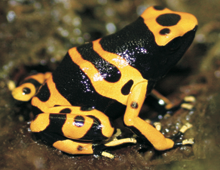Description: These dart frogs are bright orange-yellow, with black bands or stripes. They have black spots or blotches on their limbs and on their toes they have glandular, adhesive pads that help them to climb and cling. Their bright coloration, aposematic coloration, serves as a warning to would be predators that they are toxic and would not make a good meal.
Size: Adults reach lengths of 1.2 – 2.0 inches (3.1 – 5 cm) from snout to vent, making them one of the larger species of Dendrobates.
Behavior: Unique to these frogs is that they are the only known poison frog to become dormant or inactive during the dry season. They are diurnal, solitary (except when breeding), live mainly on the ground and the males are very territorial. Males will aggressively defend their calling/breeding territory by displaying behaviors such as loud calling, belly- to-belly grasping and chasing.
Diet: Their diet consists of ants, beetles, crickets, spiders, termites and other small insects that they are able to fit into their mouths. It is the combination of what they eat in the wild that makes these frogs toxic. In captivity they lose their toxicity because they are usually fed crickets and fruit flies.
Senses: Like other frogs, they have excellent eyesight that is used to locate prey.
Communication: During the breeding season, in order to attract females, males will chirp, buzz, hum and use “bird-like” trill calls. They will also show off their bright body colors. When in water pools, tadpoles use vibrations through water to let adult frogs know they are there.
Reproduction: After courtship displays, the male leads the female to his chosen breeding area, usually leaf litter close to a water source. There the female lays her clutch of eggs. The fertilized eggs are protected and cared for by the male and after a period of 10 to 14 days the eggs hatch into tiny tadpoles. The male then carries the tadpoles to small pools of water, such as a variety of water-holding plants, where they will continue to develop. After 70 to 90 days metamorphosis is complete and the tadpoles have developed into froglets.
Habitat/range: Yellow-banded dart frogs inhabit very humid and wet areas in tropical rainforests close to fresh water and can be found on trees, plants (such as bromeliads), rocks and on the forest floor in leaf litter. Their range is northern South America – Guyana, northern Brazil, Venezuela and southeastern Colombia.
Status: Listed as Least Concern on IUCN Red List; CITES, Appendix II.



